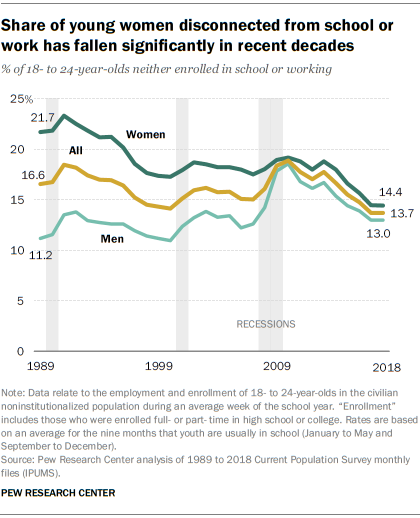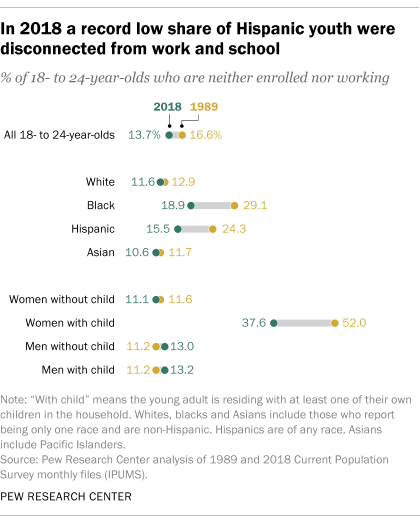The share of young adults who are not engaged in work or education has gone down gradually in recent decades and is now at its lowest point in 30 years (13.7%).

The downward trend in this figure – sometimes referred to as the “disconnection rate” – reflects in part the nation’s tight labor markets and falling unemployment, but also higher levels of engagement among young women. In 2018, only 14.4% of 18- to 24-year-old women were neither working nor enrolled in school, down from 21.7% in 1989.
A similar share of young men (13.0%) were not working or going to school in 2018. This is up marginally from 11.2% in 1989, but the share has fluctuated substantially over that period, peaking at 18.6% in 2010 in the aftermath of the Great Recession.
Lower high school dropout rates and higher college enrollment have contributed to young adults becoming more connected. In 2018, 27.4% of 18- to 24-year-olds were enrolled in school or college and not employed, up from 17.7% in 1989.

More young women are in school or working today compared with 30 years ago in part because fewer of them are mothers. Some 12.5% of 18- to 24-year-old women lived with a child in 2018, down from 25.0% in 1989. This is largely attributable to the dramatic decline in teen births in recent years. Young women who are mothers are more likely to be disconnected from education and work. In 2018, 37.6% of 18- to 24-year-old women living with at least one of their own children were not enrolled in school or employed, compared with only 11.1% of young women not living with a child.
But even among young women who are mothers, engagement in the labor force or school is greater today than in past decades. In 1989, 52.0% of 18- to 24-year-old mothers were not working or in school, compared with 37.6% today. While the opportunities for young mothers to pursue schooling or work may have increased (for example, in terms of child care or financial aid for postsecondary education), they also may be under greater financial pressure to work or pursue additional education because fewer of them are married. In 2018, 37.1% of young mothers were married, down from 58.6% in 1989.
The decline in disconnection in recent decades has been more pronounced among certain racial and ethnic groups. In 2018, a record low share of Hispanic 18- to 24-year-olds were neither in school nor working (15.5%). Last year, 18.8% of black young adults were disconnected from employment and school, a decline from 29.0% in 1989. The decline over this period in the share of white and Asian 18- to 24-year-olds who are not working or enrolled has been modest.
Disconnection rates matter because young adults who are in school or working are building valuable skills and developing networks. Youth who are neither in school nor working tend to have worse outcomes in terms of family income and home ownership in midlife compared with those who remained engaged during their late teens and early 20s.
